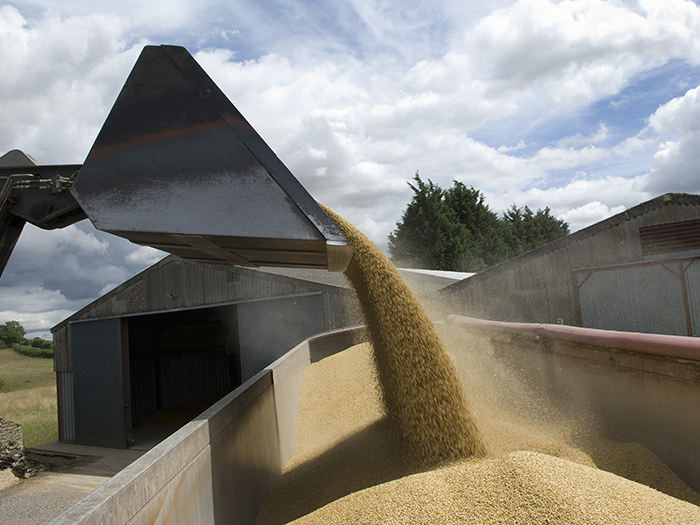4 Safety Areas That Should Be Top of Mind for Farmers as Fall’s Harvest Wraps Up

As the air turns crisp and fall returns to the U.S. in full force, many farmers will be spending their days out in the field harvesting their crops and wrapping up field work.
Harvest season is a busy and exciting time. Farmers get a sense of their yield for the year and many have to hurry to get their crops out of the fields before winter sets in. This busy time and increased workload, however, provides ample opportunity for farm safety risks to arise.
“In a lot of cases it’s a situation where the farmers are in a hurry. They’re trying to get their crops harvested,” said Nathan Bleich, vice president at Philadelphia Insurance Companies. “A lot of times when these accidents happen, it’s just a matter of people being in a hurry.”
As harvest season continues, here are four safety risks that should be top of mind for anyone working in the agricultural sector.
1) Be Cautious with ATV Use
All-terrain vehicles (ATVs) are a necessary tool for farmers. If a farmer needs to check on fencing, crops or livestock, an ATV can make it easy to cruise between fields, even in areas where there aren’t traditional roads.
While these tools are useful, they can pose huge safety risks, especially when they aren’t used properly. If someone is riding too fast or driving recklessly, they could roll over their ATV, causing severe injuries and possibly even death.
ATV accidents have resulted in concussions, broken bones, traumatic brain injuries and spinal cord trauma.

Nathan Bleich, vice president, Philadelphia Insurance Companies
In many cases, ATV accidents involve visiting family members, especially children, who may not be educated on proper safety protocols. To help prevent these types of accidents, farmers should make sure that ATV keys are kept in a secure location, so that people can’t just take off for a ride unsupervised.
Additionally, they should ensure that anyone riding an ATV is properly educated about how to ride safely, ensure that the riders have well-fitting helmets and they should supervise any rides.
“If they are going to ride it, make sure you’re supervising them, because many times the accidents happen when they’re unsupervised,” Bleich said.
Still, despite the best safety efforts, accidents can still occur. Farmers should make sure that their Farm Liability policy covers both on and off premises ATV usage.
If a farmhand is involved in an ATV accident, it could be considered a workers’ compensation claim and farmers can turn to those insurance policies to help cover the costs of recovery. It is important to know your state requirements as to when a farmer needs a workers’ compensation policy.
2) Make Sure You Enter Grain Bins Properly
Oftentimes during harvest season, a farmer or one of their workers might crawl into a grain bin to break up clumping of grain or other issues. These actions may be necessary to ensure grain flows freely when extracting the grain.
If a farmer crawls into the bin while an auger is running, they could be sucked in and seriously injured or killed in the process. “If the auger’s running and you’re taking grain out of that bin, it can be like quicksand,” Bleich said. “You just get pulled down into it and you can’t get out.”
Grain bin accidents are often fatal, since help often can’t get there in time. Even if help arrives, they may get sucked in themselves.
“It sounds crazy, but if you were even up to your knees in grain, you wouldn’t be able to pull yourself out. Nor would someone else be able to pull you out,” Bleich said.
The wet weather that comes with fall can increase the risk of grain bin accidents. Rain and snow can cause farmers to harvest crops like corn and soybeans later than usual, leading to grains that are damper and more likely to clump. In 2019, wet conditions led grain entrapments across the country to rise by 27% and deaths rose by 53%, compared to 2018.
In order to prevent these types of accidents, it’s important for farmers to ensure that augers are turned off before crawling into the bins.
“The best thing you could do is shut off the augers and make sure that it’s not pulling grain,” Bleich said.
They should also wear harnesses, which can keep them elevated if the grain shifts below them unexpectedly. Additionally, farmers should never work in grain bins alone as that increases the risk of an accident. Make sure you have an observer outside the bin that can monitor the person inside.
3) Preventing Machinery Entanglements
During harvest season, farmers spend a lot of time working with heavy machinery. From power take off shafts to grain augers, these tools can be dangerous if proper safety precautions aren’t taken.
“It can break your arms or take off limbs pretty quickly and easily,” Bleich said.
Each year, there are about 34,000 machinery entanglement injuries in the U.S. Though the manufacturing sector accounts for the bulk of these injuries, agriculture, construction and mining industries still have substantial risk.
OSHA has required that all farm machinery have guards that protect against worker contact since 1976. That way, physical barriers can help prevent a shirt sleeve or hair from getting caught in the machinery and sucking someone in.
Education can also go a long way in protecting employees by ensuring they’re aware of the risks and working safely.
“It’s really about making sure that anybody that would be around that equipment is well aware of the dangers,” Bleich said.
4) Wood Heat Safety
As winter sets in, many farmers will rely on wood heat systems to warm their shops or other out buildings. These systems can pose fire risks if they’re not properly updated and managed.
“Many shops and some of the farm buildings may have wood heat,” Bleich said.
Compounding the ever-present risk of burning wood, many of these stoves may be older or have been repaired by farmers in ways that may not be in-line with underwriters laboratories (UL) specifications. These guidelines are meant to ensure that products are independently evaluated for safety.
“A lot of times farmers are very creative. Sometimes they build their own wood stoves and things like that,” Bleich said. “The best thing farmers can do is have a stove and piping or ventilation system that is UL approved and put together according to manufacturer specifications.”
With a proper UL system in place, farmers can continue to reduce their fire risk by ensuring the area is clean and free of debris and by ensuring that chimneys and other ventilation systems are cleansed regularly.
Many companies will have a wood heat supplemental questionnaire to evaluate and rate for this increased exposure. It is important to complete these and submit them for underwriting review. &










